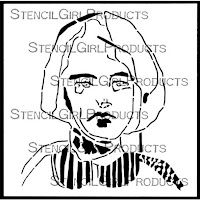Supplies:
- Black Birds in Tree Stencil
- Three Crows Stencil
- Craft Paint
- *Gesso
- *Stencil brushes
- Paint Brushes
- Utility Knife
- Leather awl or a drill
- *1/8” round paper punch
- Cardboard
- Gel Medium or Glue
- Pencil
- *Watercolor Pencils
- *Leather cord, small diameter for binding the book
- *Heavy Thread
- *Paper scraps for embellishing
* Optional
For this project I decided to make an unconventional birdhouse out of recycled cardboard.
You can use my structure design, or make a structure style to your liking. I went with a square hole and doors for my birdhouse, though many have round holes and no doors, I liked the element of surprise the doors give my structure.
SAFETY NOTE: I use a traditional utility knife, I discourage the use of Xacto knives or utility knives with the snap off blades for projects like this one as it is too easy for the blade to get stuck in the cardboard and you could potentially cut yourself.
Using the template, or a design of your choice, cut two pieces of cardboard one for the front of the book and one for the back of the book.
Once they are cut out paint the fronts and back with gesso or white craft paint, allowing to dry thoroughly between layers. I prefer gesso as it prevents the acids in the cardboard from seeping through, which can damage any treatments you add to your covers.
While the gesso was still wet I rubbed moss green and red iron oxide charcoal sticks onto the cardboard, and used a wet paint brush to spread the charcoal around and thinned it down for a more sheer effect.
Lay the Black Birds in Tree stencil on your back cover and trace out a portion of the stencil onto the cardboard. I then filled in my design using watercolor pencils in a dark indigo, sepia, wine, and yellow ochre colors. I filled in the birds using a soft grey color.
Once I had the design filled in I used a #2 round paint brush that I dampened to spread the watercolor around.
Once that side of the cover was dried, I painted the reverse side and added some texture using a sewing pattern marking wheel, and then some color with charcoal sticks, pastel pencils, and watercolor pencils.
For the front of the Birdhouse Book I decided to cut square doors, see dimensions on template.
I used a steel ruler and utility knife when making my cuts. If you should accidentally over shoot your cut lines you can, if desired, glue a decorated sheet of paper or card stock to the front of the book to hide the cut marks.
I gessoed the front of the book cover and applied some charcoal while the gesso was still wet, moving it around with a wet brush. After it dried I added sunflowers and Queen Anne’s lace to add a garden theme to the cover using watercolor pencils. When that was dried I applied one of the birds from the Black Birds in Tree stencil to the top of one of the sunflowers using a dark indigo watercolor pencil.
Once the front of the book cover was dry I gessoed the back of the cover and while wet added some moss green charcoal, I used a wet brush to move the color around while the gesso was still wet. I will probably add a design to the inside of the cover at a later date.
I then cut six more pieces of cardboard, the same shape as the covers, and glued them together using mat gel medium, and added small clamps to keep the cardboard compressed. You could weigh the stack down with some heavy books for the same affect.
Once that was dried I cut a section out of the stack in the same location as the doors on the front cover, I removed four layers of cardboard.
I then painted the back ground using some earth tone colors, with craft paint.
I then added a piece of paper, to which I added a hole the same dimensions as the cardboard piece, and stenciled my Black Birds in Tree design on part of the paper. I then attached it to the cardboard piece using gel medium.
Once that was dried I added paint to the back of the cardboard piece, and then added holes using a needle awl for the binding.
Finally, I added a bird, which I cut out of cardboard and painted with craft paint, from the Three Crows Stencil, to the niche in the cardboard piece, and a small piece of paper rolled up to make a perch for the bird.
To make the bird I traced the stencil design onto two separate pieces of cardboard, and then removed the excess bits from around the bird so that I could easily cut the bird design. Once cut out I glued the two pieces together, and added two pieces of scrap cardboard to the back of the bird so that it wasn’t laying against the niche background.
To bind the book I used a 1/8th inch hole punch and placed holes on the left sides of both covers and the middle section approximately every inch, and ¼ inch in from the edge, yielding four holes. I created the holes in the using a sewing needle awl. If necessary you could use a drill with a 1/8th inch drill bit to create the holes in the middle section.
I bound the sections together using approximately 7 ½ inch pieces of thin leather cord. I pushed the cord through the holes and then tied them together with a slip knot to finish the binding. Trim cord ends if desired, I liked mine long.


























































